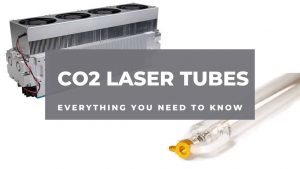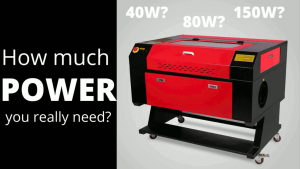CO2 laser cutters and diode laser cutters are both commonly used for cutting and engraving a variety of materials, including wood, plastic, fabric, and metal. However, there are some key differences between these two types of laser cutters that may make one more suitable for a particular application than the other.
One of the main differences between CO2 laser cutters and diode laser cutters is the type of laser they use. CO2 laser cutters use a beam of infrared light that is generated by a CO2 gas mixture, while diode laser cutters use a beam of visible light that is generated by a semiconductor diode.
Diode Laser Cutters

Diode lasers use semiconductor materials to produce laser light. The process involves injecting electrical current through a diode, which then emits photons to create a coherent laser beam. Diode lasers are typically in the visible or near-infrared spectrum, ranging from 400nm to 1000nm in wavelength.
Due to their lower power, diode lasers are commonly used for engraving materials like wood, plastic, acrylic, even some metals (with specific coatings) but also for cutting thin materials like paper or cardboard. They are popular in hobbyist and small-scale production environments.
Advantages
Precision: Diode lasers offer high precision, especially for engraving detailed designs.
Portability: Diode laser cutters are smaller and more portable than CO2 laser cutters, which makes them more suitable for use in smaller workshops or on the go. They are also generally more energy efficient, as they consume less power than CO2 laser cutters. This can be an important factor for businesses or individuals looking to reduce their energy costs or their carbon footprint.
Cooling: Typically air-cooled, making them simpler and adding to ease of portability.
Cost: diode laser cutters are generally more affordable than CO2 laser cutters, especially for smaller and less powerful models. This makes them a good choice for businesses or individuals who are just starting out with laser cutting and are looking for an affordable option.
Limitations
Power Output: Diode lasers generally have lower power outputs, usually between 1W to 20W. This makes them suitable for cutting and engraving thin materials but are quite limited when its needed to cut any thicker/denser materials.
Material Compatibility: Diode lasers are less effective on thicker or denser materials, limiting their use in industrial applications.
Speed: Lower power output translates to slower cutting speeds, especially when working with thicker materials.
CO2 Laser Cutters

CO2 lasers use a gas mixture primarily composed of carbon dioxide (CO2), nitrogen, and helium. The laser is generated by electrically stimulating this gas mixture, producing a laser beam with a wavelength around 10,600nm (in the infrared spectrum). The infrared wavelength is particularly effective for cutting and engraving organic materials.
CO2 lasers typically have higher power outputs, ranging from 40W to several hundred watts, depending on the machine’s purpose (e.g., engraving vs. cutting thick materials). Because of this they are capable of cutting and engraving a wide range of materials, including wood, acrylic, glass, fabric, rubber, leather, and even some metals (with specific setups). They are commonly used in manufacturing, signage, and prototyping.
Advantages
Power/cutting thickness: One of the main advantages of CO2 laser cutters is that they are more powerful than diode laser cutters, which means they can cut thicker and denser materials with greater ease. They are also capable of engraving at higher resolutions and producing more detailed designs. For example, CO2 laser cutters are often used in the production of signs and other decorative items, as they can produce intricate and precise designs on a wide range of materials. In addition, CO2 laser cutters are generally more durable and have a longer lifespan than diode laser cutters, which makes them a good choice for industrial or high-volume applications.
Speed: Higher power allows for faster cutting and engraving, especially with thicker or denser materials, which can make a difference in number of products you can make and sell.
Limitations
Cost: CO2 laser cutters are generally more expensive both in terms of initial investment and maintenance, which can be a barrier to entry for small businesses or individuals. In general replacement parts are more expensive and can add to their overall cost of ownership. However, they may offer a better value for money in the long run, as they are capable of cutting a wider range of materials and can be more durable.
Size and Complexity: CO2 lasers are typically larger and more complex, requiring more space and technical expertise to operate.
In conclusion, CO2 laser cutters and diode laser cutters are both useful tools for cutting and engraving a variety of materials, but they have some key differences that may make one more suitable for a particular application than the other. CO2 laser cutters are more powerful and capable of cutting thicker and denser materials, but they are larger, more expensive, and require more maintenance. Diode laser cutters are smaller, more portable, and more energy efficient, but they are not as powerful and may not be suitable for cutting thicker materials. It is important to consider the specific needs and requirements of your application when deciding which type of laser cutter to use.




